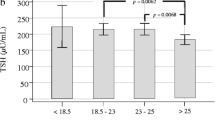Abstract
Purpose
As the lack of consensus in the initial levothyroxine (LT4) dose titration following total thyroidectomy exists, the aim of this study was to identify and quantify predictive factors for LT4 dose replacement.
Methods
A retrospective analysis of a prospectively gathered data of 234 patients who underwent total-thyroidectomy at two institutions between November 9, 2009 and January 1, 2016 was conducted. Outcome variable was the clinically observed optimal LT4 dose. Linear and polynomial regression methods were used for prediction. Continuous variables were tested for mean differences using Student’s t-test and association using Pearson’s correlation.
Results
We identified Body Surface Area (BSA) as the most significant predictor. We propose a model that titrates LT4 dose based on BSA (1.4 µg /kg/day for BSA > 1.79 m2 vs. 1.7 µg /kg/day for BSA ≤ 1.79 m2; P = 0.00). Men required higher doses than women and no differences were noted based on DM status or pathological diagnosis.
Conclusions
Our analysis shows BSA as an independent predictor of LT4 dose post total thyroidectomy. Despite the possibility of generating different equations for predicting LT4 post total-thyroidectomy, finding a practical and clinically relevant prediction model is yet of limited efficiency.


Similar content being viewed by others
References
Fish LH, Schwartz HL, Cavanaugh J, Steffes MW, Bantle JP, Oppenheimer JH (1987) Replacement dose, metabolism, and bioavailability of levothyroxine in the treatment of hypothyroidism. Role of triiodothyronine in pituitary feedback in humans. N Engl J Med 316(13):764-770. doi:10.1056/nejm198703263161302
Mosteller RD (1987) Simplified calculation of body-surface area. N Engl J Med 317(17):1098. https://doi.org/10.1056/nejm198710223171717
Jin J, Allemang MT, McHenry CR (2013) Levothyroxine replacement dosage determination after thyroidectomy. Am J Surg 205(3):360–364. https://doi.org/10.1016/j.amjsurg.2012.10.015
Elfenbein DM, Schaefer S, Shumway C, Chen H, Sippel RS, Schneider DF (2016) Prospective Intervention of a Novel Levothyroxine Dosing Protocol Based on Body Mass Index after Thyroidectomy. J Am Coll Surg 222(1):83–88. https://doi.org/10.1016/j.jamcollsurg.2015.10.005
Ojomo KA, Schneider DF, Reiher AE, Lai N, Schaefer S, Chen H, Sippel RS (2013) Using Body Mass Index to Predict Optimal Thyroid Dosing after Thyroidectomy. J Am Coll Surg 216(3):454–460. https://doi.org/10.1016/j.jamcollsurg.2012.12.002
Di Donna V, Santoro MG, de Waure C, Ricciato MP, Paragliola RM, Pontecorvi A, Corsello SM (2014) A new strategy to estimate levothyroxine requirement after total thyroidectomy for benign thyroid disease. Thyroid 24(12):1759–1764. https://doi.org/10.1089/thy.2014.0111
Olubowale O, Chadwick DR (2006) Optimization of thyroxine replacement therapy after total or near-total thyroidectomy for benign thyroid disease. Br J Surg 93(1):57–60. https://doi.org/10.1002/bjs.5157
Mistry D, Atkin S, Atkinson H, Gunasekaran S, Sylvester D, Rigby AS, England RJ (2011) Predicting thyroxine requirements following total thyroidectomy. Clin endocrinol (Oxf) 74(3):384–387. https://doi.org/10.1111/j.1365-2265.2010.03940.x
Baehr KM, Lyden E, Treude K, Erickson J, Goldner W (2012) Levothyroxine dose following thyroidectomy is affected by more than just body weight. Laryngoscope 122(4):834–838. https://doi.org/10.1002/lary.23186
Glymph K, Gosmanov AR (2016) Levothyroxine replacement in obese hypothyroid females after total thyroidectomy. Endocr Pract 22(1):22–29. https://doi.org/10.4158/ep15836.or
Sukumar R, Agarwal A, Gupta S, Mishra A, Agarwal G, Verma AK, Mishra SK (2010) Prediction of LT4 replacement dose to achieve euthyroidism in subjects undergoing total thyroidectomy for benign thyroid disorders. World J Surg 34(3):527–531. https://doi.org/10.1007/s00268-009-0345-3
Roy SK, Zeb I, Kadakia J, Li D, Budoff MJ (2012) Body surface area is a predictor of coronary artery calcium, whereas body mass index is not. Coron Artery Dis 23(2):113–117. https://doi.org/10.1097/MCA.0b013e32834f1b72
Rothman KJ (2008) BMI-related errors in the measurement of obesity. Int J Obes 32(S3):S56–S59. https://doi.org/10.1038/ijo.2008.87
Xu W, Chen Z, Li N, Liu H, Huo L, Huang Y, Jin X, Deng J, Zhu S, Zhang S, Yu Y (2015) Relationship of anthropometric measurements to thyroid nodules in a Chinese population. BMJ Open 5(12):e008452. https://doi.org/10.1136/bmjopen-2015-008452
Wang N, Fang H, Fu C, Huang P, Su M, Jiang F, Zhao Q, Chen Y, Jiang Q (2017) Associations of adiposity measurements with thyroid nodules in Chinese children living in iodine-sufficient areas: an observational study. BMJ Open 7(10):e016706. https://doi.org/10.1136/bmjopen-2017-016706
Punke AP, Waddell J (2019) Creation and evaluation of a cancer chemotherapy order review guide for use at a community hospital. J Oncol Pharm Pract 25(1):25–43. https://doi.org/10.1177/1078155217726162
Author information
Authors and Affiliations
Corresponding author
Ethics declarations
Research involving human participants
All procedures performed in studies involving human participants were in accordance with the ethical standards of the institutional research committee (KFMC-IRB approval #18–245) and with the 1964 Helsinki declaration and its later amendments or comparable ethical standards.
Conflict of interest
The authors declare that they have no conflict of interest.
Informed consent
Waived.
Additional information
Publisher's Note
Springer Nature remains neutral with regard to jurisdictional claims in published maps and institutional affiliations.
Electronic supplementary material
Below is the link to the electronic supplementary material.
Rights and permissions
About this article
Cite this article
Al-Dhahri, S.F., Al-Angari, S.S., Alharbi, J. et al. Optimal levothyroxine dose in post-total thyroidectomy patients: a prediction model for initial dose titration. Eur Arch Otorhinolaryngol 276, 2559–2564 (2019). https://doi.org/10.1007/s00405-019-05523-4
Received:
Accepted:
Published:
Issue Date:
DOI: https://doi.org/10.1007/s00405-019-05523-4




